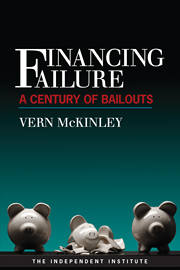The Romney-Gingrich political grudge match over Freddie Mac presents an opportunity to ask a basic question: Why are Fannie Mae and Freddie Mac still operating? Michael Williams’ recent resignation as CEO of Fannie Mae has set up a struggle over the direction of the two mortgage behemoths. It comes just a few months after Freddie Mac’s chief executive Ed Haldeman announced his departure. Will the two mortgage giants continue to muddle along in conservatorship as they have since September 2008, or will these resignations act as a catalyst to put them in receivership and wind down their operations? The latter scenario would enable taxpayers to put the fiscal disaster of these two government-sponsored enterprises behind them.
Back in August 2008 then-Treasury Secretary Paulson pulled a team together to work on resolving the deeply insolvent Fannie and Freddie. As recounted in the Andrew Ross Sorkin book, "Too Big to Fail", Robert Scully of Morgan Stanley laid out a blunt question: “Do you want to kick the can down the road?” Secretary Paulson was emphatic: “No. I want to address the issue. I don’t want to leave the problem unsolved.” Although it took guts for Paulson in combination with the Federal Housing Finance Agency to take control of Fannie and Freddie and place them in conservatorship, the problem of the two mortgage behemoths is by no means ‘solved.’ In taking control, Paulson highlighted the “flawed business model” underlying the pair.
What progress has been made in getting the Fannie and Freddie situation solved? One good benchmark we have to compare the GSEs’ conservatorship experience against is the Resolution Trust Corporation. That agency put hundreds of savings and loan institutions, and their hundreds of billions of dollars in mortgage-related assets, into conservatorship during the late 1980s and early 1990s. RTC’s primary strategy was to immediately and aggressively downsize S&Ls and transition them to private ownership.
So have Fannie and Freddie begun to downsize or unwind from their flawed business model? The SEC Form 10-K and 10-Q that they must file indicate that the answer is an unequivocal no. Fannie’s filing reveals its mortgage credit and guaranty book of business are both up since 2008 standing at over $3 trillion. Freddie’s filing reveals a mortgage portfolio that has hovered in the neighborhood of $2.2 trillion.
The Fannie Mae Board, which still exists and reports to FHFA head Ed DeMarco, has reportedly wanted to push Williams out for some time, so his resignation may be a good indicator. As a 20 year Fannie veteran he is part of the old-guard, arrogant Fannie culture of the 1990s that intertwined high leverage and political strong-arming to maintain and expand their coveted government-sponsorship. Fannie staff regularly lashed out at critics who dared question the GSE business model, publicly referring to them as “economic pencil brains.” That mentality still lingers on as some at Fannie are in denial that they are a ward of the state. Even today, they resist full transparency with the FHFA and its Inspector General and retain elements of their longstanding cavalier approach to risk management.
The FHFA could choose to support relatively superficial changes to governance and operations, like collapsing the current two-Board structure into a single board. The better decision would be to place Fannie Mae and Freddie Mac into receivership and wind down their flawed business model for good. FHFA has had this power since mid-2008, before the GSEs were placed into conservatorship. Newt Gingrich, former consultant to Freddie Mac, discussed a plan on Meet the Press the morning after his big South Carolina win whereby the pair would be “broken up into four or five much smaller companies” to transition them back to private hands. Receivership would allow implementation of such a plan.
I can already hear the familiar refrain from those that have a vested interest in perpetuating the flawed business model that any such plan would devastate the nascent housing recovery. This refrain would be supported by the Federal Reserve, which has recently weighed in on the politically charged issue of Fannie and Freddie’s role in the housing market. This crowd also made the argument in the 1990s that Fannie and Freddie were the ultimate free lunch and we should leverage them to push the homeownership rate up toward 70%. Clearly that did not end well for taxpayers. These are also the people that argued in 2008 that Fannie and Freddie could not be placed into conservatorship because that would devastate the housing market in the midst of a financial crisis. Given its track record, we have to stop listening to that discredited crowd.







